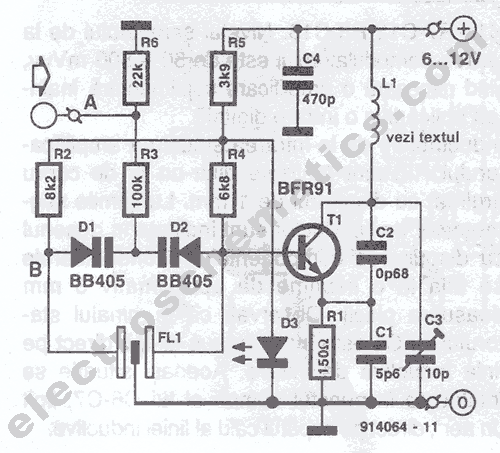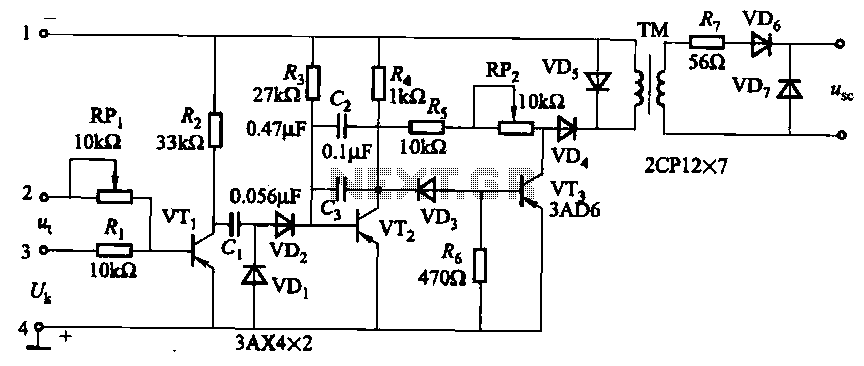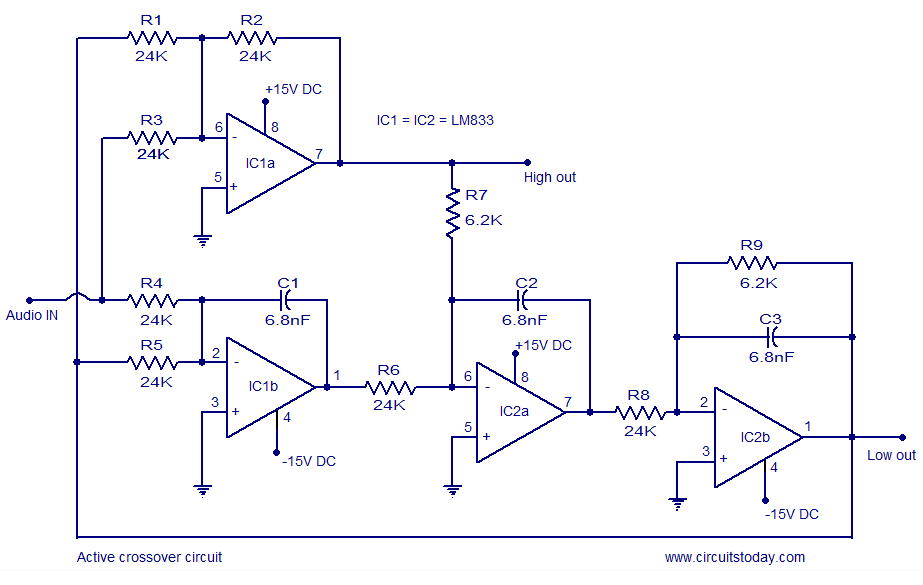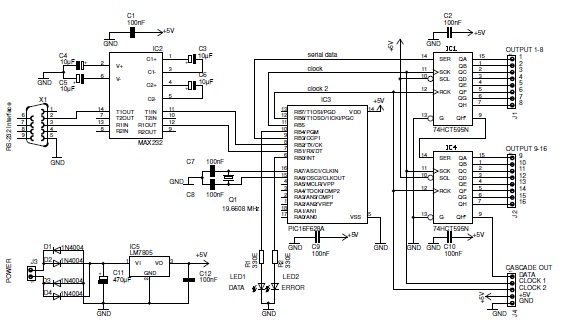
USB FM Transmitter Circuit

A simple USB FM transmitter that can be used to play audio files from an MP3 player or computer on a standard VHF FM radio by connecting it to a USB port. The circuit does not require any coils to be wound. This USB transmitter allows for listening to personal music throughout the home. To maintain simplicity and compactness, a chip from Maxim Integrated Products, the MAX2606, is utilized. This integrated circuit from the MAX2605-MAX2609 series is specifically designed for low-noise RF applications with a fixed frequency. The VCO (Voltage Controlled Oscillator) in this IC employs a Colpitts oscillator circuit. Additionally, the variable-capacitance (varicap) diode and feedback capacitors for tuning are integrated into the chip, requiring only an external inductor to set the central oscillator frequency. Frequency fine-tuning is achieved by varying the voltage to the varicap. The inductor required has a relatively low Q factor (35 to 40), as specified by Maxim. The IC operates with a supply voltage between 2.7 and 5.5 V, consuming between 2 and 4 mA of current, making USB power supply a suitable option. A common-mode choke is connected in series with the USB connections to prevent interference with the PC supply. The circuit is straightforward, with a stereo signal connected to K1, combined through R1 and R2, and passed through volume control P1 to the Tune input of IC1, where it modulates the carrier wave frequency. Filter R6/C7 restricts the audio signal bandwidth. Frequency setting across the VHF FM broadcast band is managed by P2, connected to the 5 V supply. The PCB uses 0805 SMD resistors and capacitors and measures only 41.2 x 17.9 mm, making it practically dongle-sized. An almost straight copper track serves as the aerial at the board's edge. The transmitter achieves a range of approximately 6 meters (18 feet). A 5-way SIL header on the board accommodates inputs for the 3.5 mm jack plug, input to P1, and supply voltage, allowing independent powering from mains via three AA batteries or a Lithium button cell. Inductor L1 in the prototype is a Murata type with a minimum Q factor of 60 at 100 MHz. Care is needed when soldering filter choke L2 due to closely positioned connections, which are connected to the supply voltage, necessitating checks to avoid shorts. P1 operates inversely, reducing volume when turned clockwise, facilitating board layout. The deviation and audio bandwidth vary with P1's setting. Maximum audio input sensitivity is significant; a stereo input of 10 mVrms is sufficient at maximum P1 setting for clear sound transmission. This depends on the VCO setting, with higher tuning voltage allowing for larger input signals, beyond which distortion may occur. If attenuation is difficult to set with P1, increasing R1 and R2 values is feasible. RF analyzer measurements indicated a strong presence of the third harmonic in the transmitted spectrum at about 10 dB below the fundamental frequency, which ideally should be lower. Bandwidth varies from 13.1 kHz with a low-impedance source connected to both inputs at maximum P1.
The USB FM transmitter circuit is designed for easy integration into various audio applications, providing a straightforward solution for wireless audio streaming. The use of the MAX2606 integrated circuit simplifies the design by minimizing the number of external components required, enhancing reliability and reducing assembly complexity. The incorporation of a common-mode choke is critical for maintaining signal integrity, especially in environments with potential RF interference.
The audio input stage, which utilizes resistors R1 and R2 for combining stereo signals, allows for flexibility in audio source compatibility. The volume control potentiometer P1 not only adjusts the output level but also influences the modulation characteristics of the transmitter, providing a unique approach to managing audio levels.
The PCB layout is optimized for size, making it suitable for portable applications, while the choice of SMD components ensures a compact form factor. The design's ability to operate on USB power or batteries adds to its versatility for various use cases, whether at home or on the go.
Overall, this USB FM transmitter represents an effective solution for users seeking to broadcast audio wirelessly, with considerations for performance, size, and ease of use. The design allows for customization and adjustments based on user preferences, making it a valuable addition to personal audio equipment.A simple USB FM transmitter that could be used to play audio files from an MP3 player or computer on a standard VHF FM radio by connecting it to an USB port. The circuit use no coils that have to be wound. This USB transmitter can be used to listen to your own music throughout your home. To keep the fm transmitter circuit simple as well as compact, it was decided to use a chip made by Maxim Integrated Products, the MAX2606. This IC from the MAX2605-MAX2609 series has been specifically designed for low-noise RF applications with a fixed frequency. The VCO (Voltage Controlled Oscillator) in this IC uses a Colpitts oscillator circuit. The variable-capacitance (varicap) diode and feedback capacitors for the tuning have also been integrated on this chip, so that you only need an external inductor to fix the central oscillator frequency.
It is possible to fine-tune the frequency by varying the voltage to the varicap. Not much is demanded of the inductor, a type with a relatively low Q factor (35 to 40) is sufficient according to Maxim. The supply voltage to the IC should be between 2. 7 and 5. 5 V, the current consumption is between 2 and 4 mA. With values like these it seemed a good idea to supply the circuit with power from a USB port. A common-mode choke is connected in series with the USB connections in order to avoid interference between the circuit and the PC supply.
There is not much else to the circuit. The stereo signal connected to K1 is combined via R1 and R2 and is then passed via volume control P1 to the Tune input of IC1, where it causes the carrier wave to be frequency modulated. Filter R6/C7 is used to restrict the bandwidth of the audio signal. The setting of the frequency (across the whole VHF FM broadcast band) is done with P2, which is connected to the 5 V supply voltage.
The PCB designed uses resistors and capacitors with 0805 SMD packaging. The size of the board is only 41. 2 x 17. 9 mm, which is practically dongle-sized. For the aerial an almost straight copper track has been placed at the edge of the board. In practice we achieved a range of about 6 metres (18 feet) with this fm transmitter usb. There is also room for a 5-way SIL header on the board. Here we find the inputs to the 3. 5 mm jack plug, the input to P1 and the supply voltage. The latter permits the circuit to be powered independently from the mains supply, via for example three AA batteries or a Lithium button cell. Inductor L1 in the prototype is a type made by Murata that has a fairly high Q factor: minimum 60 at 100 MHz.
Take care when you solder filter choke L2, since the connections on both sides are very close together. The supply voltage is connected to this, so make sure that you don`t short out the USB supply! Use a resistance meter to check that there is no short between the two supply connectors before connecting the circuit to a USB port on a computer or to the batteries.
P1 has the opposite effect to what you would expect (clockwise reduces the volume), because this made the board layout much easier. The deviation and audio bandwidth varies with the setting of P1. The maximum sensitivity of the audio input is fairly large. With P1 set to its maximum level, a stereo input of 10 mVrms is sufficient for the sound on the radio to remain clear.
This also depends on the setting of the VCO. With a higher tuning voltage the input signal may be almost twice as large (see VCO tuning curve in the data sheet). Above that level some audible distortion becomes apparent. If the attenuation can`t be easily set by P1, you can increase the values of R1 and R2 without any problems.
Measurements with an RF analyzer showed that the third harmonic had a strong presence in the transmitted spectrum (about 10 dB below the fundamental frequency). This should really have been much lower. With a low-impedance source connected to both inputs the bandwidth varies from 13. 1 kHz (P1 at maximum 🔗 External reference
The USB FM transmitter circuit is designed for easy integration into various audio applications, providing a straightforward solution for wireless audio streaming. The use of the MAX2606 integrated circuit simplifies the design by minimizing the number of external components required, enhancing reliability and reducing assembly complexity. The incorporation of a common-mode choke is critical for maintaining signal integrity, especially in environments with potential RF interference.
The audio input stage, which utilizes resistors R1 and R2 for combining stereo signals, allows for flexibility in audio source compatibility. The volume control potentiometer P1 not only adjusts the output level but also influences the modulation characteristics of the transmitter, providing a unique approach to managing audio levels.
The PCB layout is optimized for size, making it suitable for portable applications, while the choice of SMD components ensures a compact form factor. The design's ability to operate on USB power or batteries adds to its versatility for various use cases, whether at home or on the go.
Overall, this USB FM transmitter represents an effective solution for users seeking to broadcast audio wirelessly, with considerations for performance, size, and ease of use. The design allows for customization and adjustments based on user preferences, making it a valuable addition to personal audio equipment.A simple USB FM transmitter that could be used to play audio files from an MP3 player or computer on a standard VHF FM radio by connecting it to an USB port. The circuit use no coils that have to be wound. This USB transmitter can be used to listen to your own music throughout your home. To keep the fm transmitter circuit simple as well as compact, it was decided to use a chip made by Maxim Integrated Products, the MAX2606. This IC from the MAX2605-MAX2609 series has been specifically designed for low-noise RF applications with a fixed frequency. The VCO (Voltage Controlled Oscillator) in this IC uses a Colpitts oscillator circuit. The variable-capacitance (varicap) diode and feedback capacitors for the tuning have also been integrated on this chip, so that you only need an external inductor to fix the central oscillator frequency.
It is possible to fine-tune the frequency by varying the voltage to the varicap. Not much is demanded of the inductor, a type with a relatively low Q factor (35 to 40) is sufficient according to Maxim. The supply voltage to the IC should be between 2. 7 and 5. 5 V, the current consumption is between 2 and 4 mA. With values like these it seemed a good idea to supply the circuit with power from a USB port. A common-mode choke is connected in series with the USB connections in order to avoid interference between the circuit and the PC supply.
There is not much else to the circuit. The stereo signal connected to K1 is combined via R1 and R2 and is then passed via volume control P1 to the Tune input of IC1, where it causes the carrier wave to be frequency modulated. Filter R6/C7 is used to restrict the bandwidth of the audio signal. The setting of the frequency (across the whole VHF FM broadcast band) is done with P2, which is connected to the 5 V supply voltage.
The PCB designed uses resistors and capacitors with 0805 SMD packaging. The size of the board is only 41. 2 x 17. 9 mm, which is practically dongle-sized. For the aerial an almost straight copper track has been placed at the edge of the board. In practice we achieved a range of about 6 metres (18 feet) with this fm transmitter usb. There is also room for a 5-way SIL header on the board. Here we find the inputs to the 3. 5 mm jack plug, the input to P1 and the supply voltage. The latter permits the circuit to be powered independently from the mains supply, via for example three AA batteries or a Lithium button cell. Inductor L1 in the prototype is a type made by Murata that has a fairly high Q factor: minimum 60 at 100 MHz.
Take care when you solder filter choke L2, since the connections on both sides are very close together. The supply voltage is connected to this, so make sure that you don`t short out the USB supply! Use a resistance meter to check that there is no short between the two supply connectors before connecting the circuit to a USB port on a computer or to the batteries.
P1 has the opposite effect to what you would expect (clockwise reduces the volume), because this made the board layout much easier. The deviation and audio bandwidth varies with the setting of P1. The maximum sensitivity of the audio input is fairly large. With P1 set to its maximum level, a stereo input of 10 mVrms is sufficient for the sound on the radio to remain clear.
This also depends on the setting of the VCO. With a higher tuning voltage the input signal may be almost twice as large (see VCO tuning curve in the data sheet). Above that level some audible distortion becomes apparent. If the attenuation can`t be easily set by P1, you can increase the values of R1 and R2 without any problems.
Measurements with an RF analyzer showed that the third harmonic had a strong presence in the transmitted spectrum (about 10 dB below the fundamental frequency). This should really have been much lower. With a low-impedance source connected to both inputs the bandwidth varies from 13. 1 kHz (P1 at maximum 🔗 External reference





